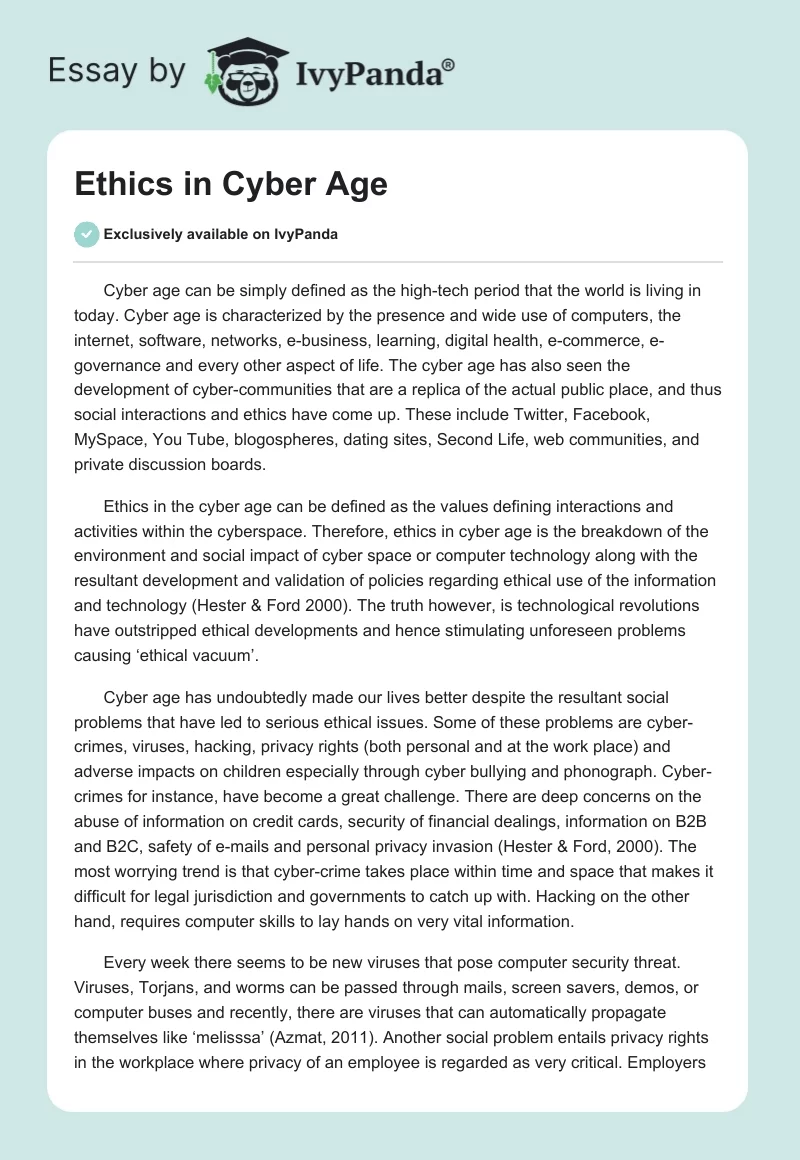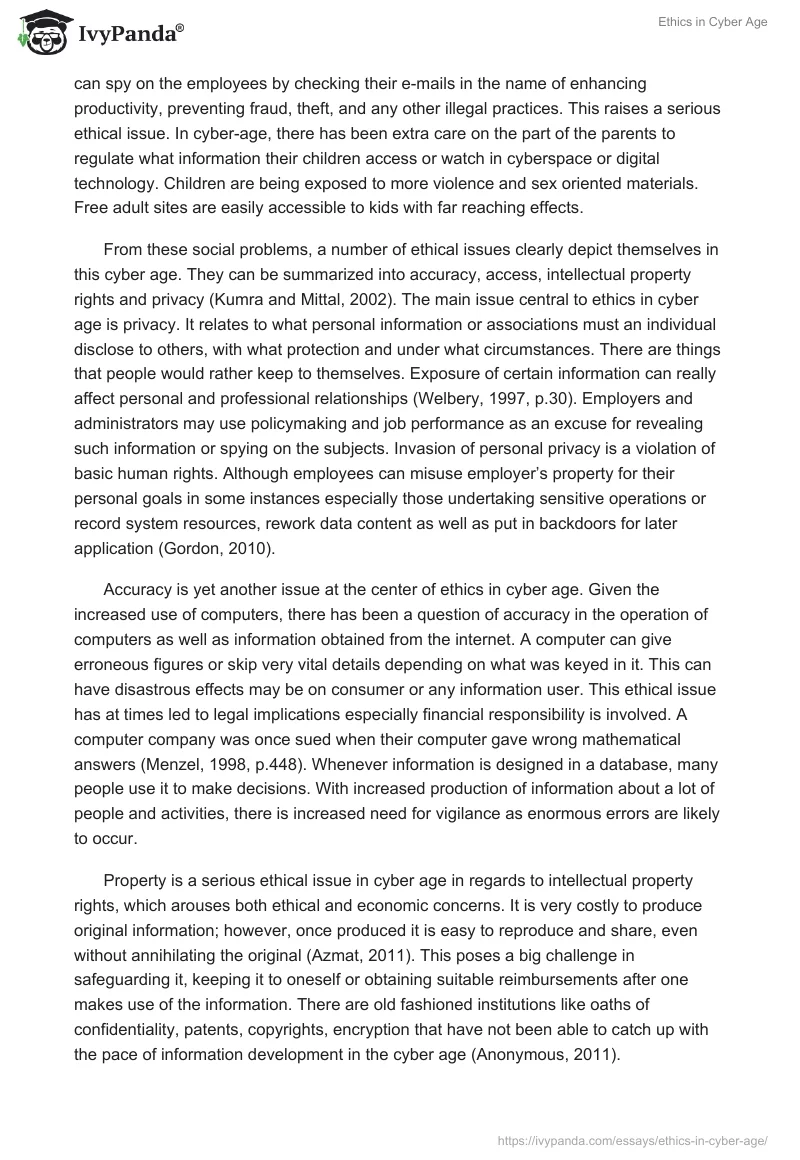Cyber age can be simply defined as the high-tech period that the world is living in today. Cyber age is characterized by the presence and wide use of computers, the internet, software, networks, e-business, learning, digital health, e-commerce, e-governance and every other aspect of life. The cyber age has also seen the development of cyber-communities that are a replica of the actual public place, and thus social interactions and ethics have come up. These include Twitter, Facebook, MySpace, You Tube, blogospheres, dating sites, Second Life, web communities, and private discussion boards.
Ethics in the cyber age can be defined as the values defining interactions and activities within the cyberspace. Therefore, ethics in cyber age is the breakdown of the environment and social impact of cyber space or computer technology along with the resultant development and validation of policies regarding ethical use of the information and technology (Hester & Ford 2000). The truth however, is technological revolutions have outstripped ethical developments and hence stimulating unforeseen problems causing ‘ethical vacuum’.
Cyber age has undoubtedly made our lives better despite the resultant social problems that have led to serious ethical issues. Some of these problems are cyber-crimes, viruses, hacking, privacy rights (both personal and at the work place) and adverse impacts on children especially through cyber bullying and phonograph. Cyber-crimes for instance, have become a great challenge. There are deep concerns on the abuse of information on credit cards, security of financial dealings, information on B2B and B2C, safety of e-mails and personal privacy invasion (Hester & Ford, 2000). The most worrying trend is that cyber-crime takes place within time and space that makes it difficult for legal jurisdiction and governments to catch up with. Hacking on the other hand, requires computer skills to lay hands on very vital information.
Every week there seems to be new viruses that pose computer security threat. Viruses, Torjans, and worms can be passed through mails, screen savers, demos, or computer buses and recently, there are viruses that can automatically propagate themselves like ‘melisssa’ (Azmat, 2011). Another social problem entails privacy rights in the workplace where privacy of an employee is regarded as very critical. Employers can spy on the employees by checking their e-mails in the name of enhancing productivity, preventing fraud, theft, and any other illegal practices. This raises a serious ethical issue. In cyber-age, there has been extra care on the part of the parents to regulate what information their children access or watch in cyberspace or digital technology. Children are being exposed to more violence and sex oriented materials. Free adult sites are easily accessible to kids with far reaching effects.
From these social problems, a number of ethical issues clearly depict themselves in this cyber age. They can be summarized into accuracy, access, intellectual property rights and privacy (Kumra and Mittal, 2002). The main issue central to ethics in cyber age is privacy. It relates to what personal information or associations must an individual disclose to others, with what protection and under what circumstances. There are things that people would rather keep to themselves. Exposure of certain information can really affect personal and professional relationships (Welbery, 1997, p.30).
Employers and administrators may use policymaking and job performance as an excuse for revealing such information or spying on the subjects. Invasion of personal privacy is a violation of basic human rights. Although employees can misuse employer’s property for their personal goals in some instances especially those undertaking sensitive operations or record system resources, rework data content as well as put in backdoors for later application (Gordon, 2010).
Accuracy is yet another issue at the center of ethics in cyber age. Given the increased use of computers, there has been a question of accuracy in the operation of computers as well as information obtained from the internet. A computer can give erroneous figures or skip very vital details depending on what was keyed in it. This can have disastrous effects may be on consumer or any information user. This ethical issue has at times led to legal implications especially financial responsibility is involved. A computer company was once sued when their computer gave wrong mathematical answers (Menzel, 1998, p.448). Whenever information is designed in a database, many people use it to make decisions. With increased production of information about a lot of people and activities, there is increased need for vigilance as enormous errors are likely to occur.
Property is a serious ethical issue in cyber age in regards to intellectual property rights, which arouses both ethical and economic concerns. It is very costly to produce original information; however, once produced it is easy to reproduce and share, even without annihilating the original (Azmat, 2011). This poses a big challenge in safeguarding it, keeping it to oneself or obtaining suitable reimbursements after one makes use of the information. There are old fashioned institutions like oaths of confidentiality, patents, copyrights, encryption that have not been able to catch up with the pace of information development in the cyber age (Anonymous, 2011).
According to Barger, 2008, one ought to have intellectual skills like writing, reading, calculating, and reasoning to handle information. Many information poor individuals cannot access effective computer technology. Similarly, to access database one must have a personal computer or a terminal (Lee & Chain, 2009, p.2). This implies that to access information; one must know it exists, have gained necessary expertise for access and be able to pay for it. This excludes many people from accessing the information.
In conclusion, the high-tech era we live in today has come with social problems that have forced scholars to look into ethics in the cyber age. Various problems like cyber-crime, privacy, and exposure to children are of great concern. Privacy, access, intellectual property rights, and accuracy are the main issues in this regard.
Reference List
- Anonymous. (2011). Cyber ethics, Computer Crime & Intellectual Property Section. United States Department of Justice.
- Azmat, B. (2011). Cyber ethics (Information System Ethics). Ezine articles. Web.
- Barger, R. (2008). Computer Ethics; a Case-Based Approach. New York: Cambridge University Press.
- Gordon, E. (2010). The future of jobs, talent creation, and what the “cyber-mental age” will mean to everyone. Training and Development.
- Hester, M., and Ford, P. (2000). Computer and Ethics in the Cyber Age. New Jersey, USA: Prentice Hall.
- Kumra, R., and Mittal, R. (2002). Ethical Issues in Cyber Age. Delhi Business Review, 3 (1), 1-4. Web.
- Lee, W., and Chain, K. (2009). Computer Ethics: A Potent Weapon for Information Security Management. Journal Online.
- Menzel, D. (1998). Issues and Challenges Facing Public Managers. Public Administration Review, 58(5), 445-452.
- Welbery, B. (1997). “For Your Eyes Only” …means what is the cyber age? ABA Banking Joucrnal, 89(12), 30.


